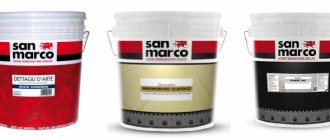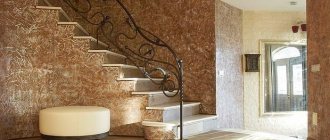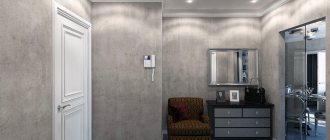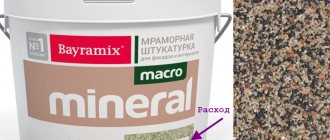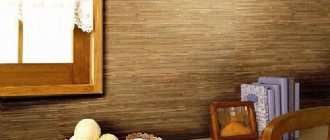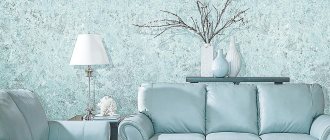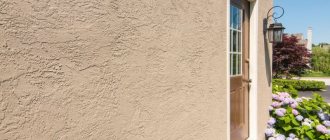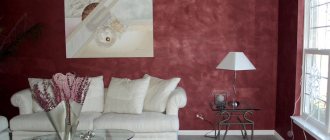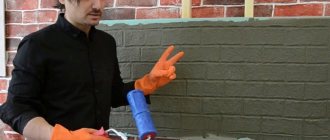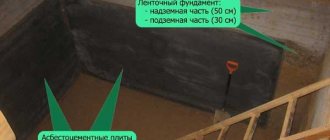Painting features
Before you begin work, you should familiarize yourself with the properties and characteristics of the material, as well as the rules of the technological process for a high-quality and durable finish.
Compliance with the rules for choosing materials and correctly performed work will ensure not only a beautiful appearance of the walls, but will also save money on remodeling.
Double painting with bark beetle has a number of features, the observance of which will ultimately allow you to achieve a high-quality result. To perform such work, you do not need much experience; you just need to familiarize yourself with the technology in detail.
Choosing finishes in the kitchen - photos and views in the design of modern apartments
Due to a number of special kitchen conditions - temperature changes, odors, excessive humidity and others, you can make a list of small tips:
- Decorative plaster in the kitchen, photos and types of which are presented in the catalog, is designed to decorate the room, add chic to it, and place accents. Therefore, it is more appropriate and aesthetically pleasing when separate zones are decorated with it. But we don’t advise you to highlight the apron with plaster; here, rely on tiles or fiberglass.
- Choose your color carefully; shades that are too light will get lost, while shades that are too bright will catch your eye and “heavien” the interior.
- Don't stop at just the kitchen walls! All unsuccessful or rather laconic plasterboard boxes, niches, arches, and ceilings are perfectly played out with the help of a coating.
- Read more about finishing
Gray on a non-load bearing support
Blue in the eating area
Brown textured apron in the kitchen
In a white interior
Gray and beige with lamp
In the kitchen with a bar counter
Factrunaya
In the kitchen at the dacha
In the apartments on the ground floor
Plaster in high-tech style
Modern style renovation
Brown in the studio
In a small dining room
Pink with white stripes
The main disadvantages of the bark beetle
The use of this finishing option for interior decoration has some difficulties, which include:
- Quite a labor-intensive surface treatment process;
- An attractive appearance is achieved only with properly performed work, which is quite difficult to achieve;
- In most cases, it is recommended to contact professional craftsmen in order to obtain a high-quality finish.
However, despite all the difficulties in performing plastering in this way, there are also positive aspects. For example, walls can be painted multiple times, with recesses and depressions painted in one tone, and the rest of the surface in another, which looks quite original.
Application rules
Wall covering is carried out according to the following points:
- The wall is perfectly cleaned of old coating, dirt and grease.
- It is perfectly smooth, which is achieved with putty.
- The surface is primed to the deepest layers with a special primer to protect against mold and improve thermal insulation.
- The first layer of white plaster is thin.
- A pattern is already formed from the second colored layer using a spatula, sponge, roller or just your hands; in the case of the Venetian, they are painted and covered with wax.
Options for decorative plaster
When choosing, remember that:
- working with the liquid composition is quite difficult; it cannot be diluted twice;
- if there is a large suspension in the plaster, then you should work with it exclusively by hand;
- in the case of a polymorphic suspension, it is necessary to ensure that small particles do not spill out of the applied layer;
- if the base is aqueous, then it is less toxic, but more susceptible to adverse environmental factors.
The main advantages of double plastering
Painting with decorative plaster in two colors actually has many advantages.
Among which are the following:
- This method of wall decoration allows you to create an original and unique design, and with a skillful choice of colors you can create various design solutions;
- Protection from moisture and direct sunlight;
- When choosing light colors, the walls will not overheat in the summer.
Features of the use of decorative plaster, advantages and disadvantages
Decorative plaster is a universal coating that can be used to create decor of any complexity, texture, color and volume. The uniqueness of this material is that it is convenient to use for finishing a room in any interior style. For example, a classic or antique style with columns and ceiling stucco can be complemented with plaster in the form of antique stonework, pompous Rococo with rich Venetian plaster, modern fusion with large waves or a floral pattern.
Textured surface finishes were available back in the Middle Ages and Renaissance. Decorative plaster in the interior replaced finishing with expensive stone or marble. It is much easier to work with marble chips than with a heavy monolith. At the same time, the cost of the crumbs is several times cheaper. The secret was in a special way of applying it to the wall. Many masters kept the composition secret, using similar decor in the houses of the nobility.
Today, the method of decorating rooms with marble, stone or wood is also popular, but is already more affordable. Using decorative putty, craftsmen decorate banquet halls of restaurants, lobbies of department stores and hotels, or residential premises.
Using decorative putty, a master can create various textures on a wall or ceiling:
- cross section of the tree;
- stone or brickwork;
- panel made of leather, silk or slightly wrinkled fabric;
- volumetric artistic bas-relief;
- crocodile or snake skin pattern.
Note: decorative plaster is available not only in white, but also in various other colors and shades, in the form of a dry mixture or ready-made solution. It may contain various fillers: marble chips, natural fibers, mineral dust, antiseptic additives and preservatives. Depending on the fillers, decorative plaster looks different on the surface.
Advantages of decorative plaster
Modern designers, builders and decorators prefer plaster for many reasons:
- To apply textured plaster, there is no need to additionally level and treat the surface; it is enough to apply a primer for good adhesion to the surface;
- It is easier to decorate complex surfaces with a viscous composition - plasterboard structures, columns, niches, semicircular walls;
- When the coating dries, it does not create joints or seams, but creates the appearance of a solid surface (the master applies the plaster to the entire surface gradually, preventing it from drying out and taking on an irregular shape);
- the mixture can be colored in any suitable color, which makes it possible to decorate the room according to the intended project;
- types of decorative plaster allow you to choose the right option for any historical or ethnic style;
- a protective coating or special components of the mixture allow the plaster to retain its original appearance for a long time without losing its colors, texture or wearing out.
The advantage of such a coating is also its high artistic aesthetics, which is difficult to achieve with other materials. In other words, the richness and luxury of Venetian or silk plaster is difficult to convey using other finishing materials.
Disadvantages of decorative plaster
During the purchase, finishing and operation of the material, despite all sorts of advantages, you may encounter tangible disadvantages. For example, the cost of some types of plaster is quite high, as is the cost of applying it. Some types of plaster require complex surface preparation, others are not strong enough for exterior decoration and are only suitable for finishing interior ceilings.
There are several other disadvantages:
- if the house is located in a seismically active area, then the plaster from its walls will collapse or crack during tremors;
- if the room is very humid, the coating will not last long;
- if the apartment is in a new building, then cracks may appear on the walls due to the process of shrinkage of the soil under the house.
Rules for choosing paint
In order to choose the right decorative bark beetle plaster, it is still recommended to consult with a specialist, because further wall finishing depends on the quality of the material.
There are two types of such paint: white and colored. The use of white paint requires additional processing, for example, painting in a certain color.
Colored plaster is offered in a wide range of color palettes and is sold in ready-made form, which just needs to be applied to the surface.
What to consider when decorating a living room
Decorative plaster can become the main material for finishing a room. A combination with wallpaper or stone panels is also possible.
If you have chosen a classic type of interior, then you can plaster the surface of the walls and ceiling with the decorative elements used.
- Welding work of any complexity from a company in Moscow
- Ceramic tiles are a modern choice for renovation!
- High-quality living room renovation of any complexity from professionals
It is often necessary to provide a visual enlargement of a room. Therefore, it is better to opt for light shades with high reflective characteristics.
The elegance and sophistication of the living room interior is ensured by Venetian plaster with a golden or silver sheen.
Light shades of design can be complemented by materials with a pearlescent or metallic sheen. The presence of large particles in the composition will give the living room a three-dimensional perception.
To decorate the walls, you can use panels, which are created through the use of plasters of different textures. The thematic orientation of such a design can be different - from naturalistic to expressionism. And you can determine the size of the picture yourself.
The living room will benefit from a ceiling with patterns, carving and stone effects. It is often recommended to combine plaster with wallpaper and fragments for painting.
Here it is important to properly disguise the joints. For this you can use slats or thresholds.
When choosing decorative plaster, you should take into account the finishing area, the features of the wall or ceiling, and climatic conditions.
By choosing the right finishing material in accordance with the overall style of the living room, you will get an original and cozy room for all family members.
Paint application technology
After choosing the tone of the plaster, they begin to prepare the walls, namely, thoroughly clean them of all kinds of dirt, old coating and dust. If necessary, the surfaces should be leveled and any existing defects and imperfections should be removed.
Direct painting of walls can be done in several ways. For example, you can apply plaster to the prepared surface or add another shade to the pre-prepared mixture. You can also combine colors on the walls, thus creating a beautiful style in the interior, emphasizing individuality.
To plaster a room, you will need a certain set of devices, which includes a special container with plates and spikes, brushes and rollers.
Before plastering, you should cover the furniture and floor with a protective film to prevent the plaster from getting on them.
How to apply decorative plaster
Clean the base from any decorative coatings, paint, or anything that may peel off. Get rid of greasy and dirty stains, construction dust and small fibers. Use regular putty and sealant to patch cracks, potholes and other defects, and dry.
Be sure to apply a primer that matches your type of plaster. It improves the adhesion of the finish to the wall so that in the future the plaster does not fall off in pieces. Use primers with beneficial additives, such as fungicides or antiseptics.
If you have a thin-layer and finely dispersed mixture, it is better to apply a leveling layer first. This is a traditional starting putty with a coarse filler like sand. Vary the number of layers depending on the situation, but be sure to dry everything and coat it with primer again.
Decorative plaster is applied with a spatula using wide strokes, directly or in an arc. You can create texture with a trowel by pressing it against the wet mortar and sharply pulling it back. It’s even easier to take a roller that already has the desired design applied to it. To give relief, various available materials are suitable - sponge, film, fabric, brushes, everything is used.
Wall painting options
There is more than one way to paint walls with decorative plaster.
Which include:
- Painting in one layer. The simplest option for wall decoration, which does not require professional skills and uses one type of material;
- Dry brush option. This method involves applying a starting layer of a dark color, onto which, after drying, a lighter shade is applied. This allows you to create a relief and volumetric design, and to complete the work you will need a brush with short bristles;
- Blur. This painting method allows you to visually highlight depressions on surfaces, for which darker tones are used. This finishing option is considered the most labor-intensive compared to other methods and requires significant material costs, as well as more time for plastering.
Decorative plaster in the interior - photos and ideas
It is difficult to think of a situation, room or style for which it would not be possible to find a suitable collection of decorative plaster.
Furniture handles (70 photos): types, materials
Recommendations for quality work performance
When painting with decorative plaster in two colors, varnish can be used as a final protective layer. It is applied after the bark beetle has completely dried, and for work it is recommended to purchase a water-based varnish.
In order for it to better penetrate deep into the plaster, it is diluted by half with water. The varnish is applied in several passes after the previous layer has dried. This varnish coating not only additionally protects the walls, but also gives them shine, attractiveness and originality of finish.
Watch the video:
It is necessary to apply the varnish to the entire wall, while avoiding smudges, so that in the end there are no unsightly marks left on the coating. And for applying it, it is better to use a wide brush, which is wrung out well before applying the varnish to the wall.
How to paint textured plaster with your own hands
The work is divided into two main stages: surface preparation and paint application. Time must pass between them so that the previous layer has time to dry. Tools needed for painting textured plaster:
- Sandpaper for surface preparation;
- A damp cloth for cleaning;
- Paint roller or spray gun for applying paint;
- Tray if using a roller;
- A hard brush for painting corners, areas near a door or window;
- A sponge for applying a second coat of paint (if any).
For varnish, a roller is used - a separate one or the same one, but thoroughly washed. The room where you are supposed to work should be dry and warm, and you need the opportunity to ventilate. If the work is supposed to be done outside, then it should be scheduled for a warm and dry time, preferably in natural light, for example, on a warm summer day.
We use plaster on the balcony
Balconies and loggias are so different. In someone’s apartment, this place serves as a haven for relaxation and reflection; there is a small sofa there, flowers grow, and the panorama opens onto a beautiful park. And for some, this is the most functional and practical room; they store bicycles, skis and locking boxes in it.
In favor of choosing plaster on the balcony, we note its ability to retain heat and perfectly soundproof the walls.
We do not recommend taking a Venetian - it may be “sensitive” to changes in weather conditions on an unglazed balcony. But a textured one is excellent, with the help of which various effects are created: “antique”, crinkled fabric, cracks, “bark beetle” or “soft gold” - antibacterial with special granules.
The gallery below contains photos of decorative plaster on the balcony.
With a picture on the wall
On the loggia
Behind the bench
On the balcony
Above double glazed windows
In the hookah room
Under the windowsill
In light beige with tiles
Composition “Castle”
Unusual
Opposite the table
In yellow tones
Venetian plaster on the balcony
With stone insert
